HRM Practices Analysis Report: ITV Employee Relations
VerifiedAdded on 2019/12/18
|26
|6608
|249
Report
AI Summary
This report provides a comprehensive overview of human resource management (HRM) practices, employee relations, and employment legislation, with a specific focus on the context of ITV. The report is structured into several tasks, covering the purpose and scope of HRM, key elements of HRM, and the internal and external factors that influence HRM decision-making. It also explores the application of HRM practices, analyzes the importance of maintaining good employee relations, and examines the influence of employment legislation on ITV's HR decisions. The report includes discussions on job specifications, person specifications, and the evaluation of employee relations management and HRM practices, culminating in a critical evaluation of employee relations and HRM applications within ITV. The report incorporates relevant literature and provides insights into various aspects of HRM, aiming to inform and influence decision-making within the organization.
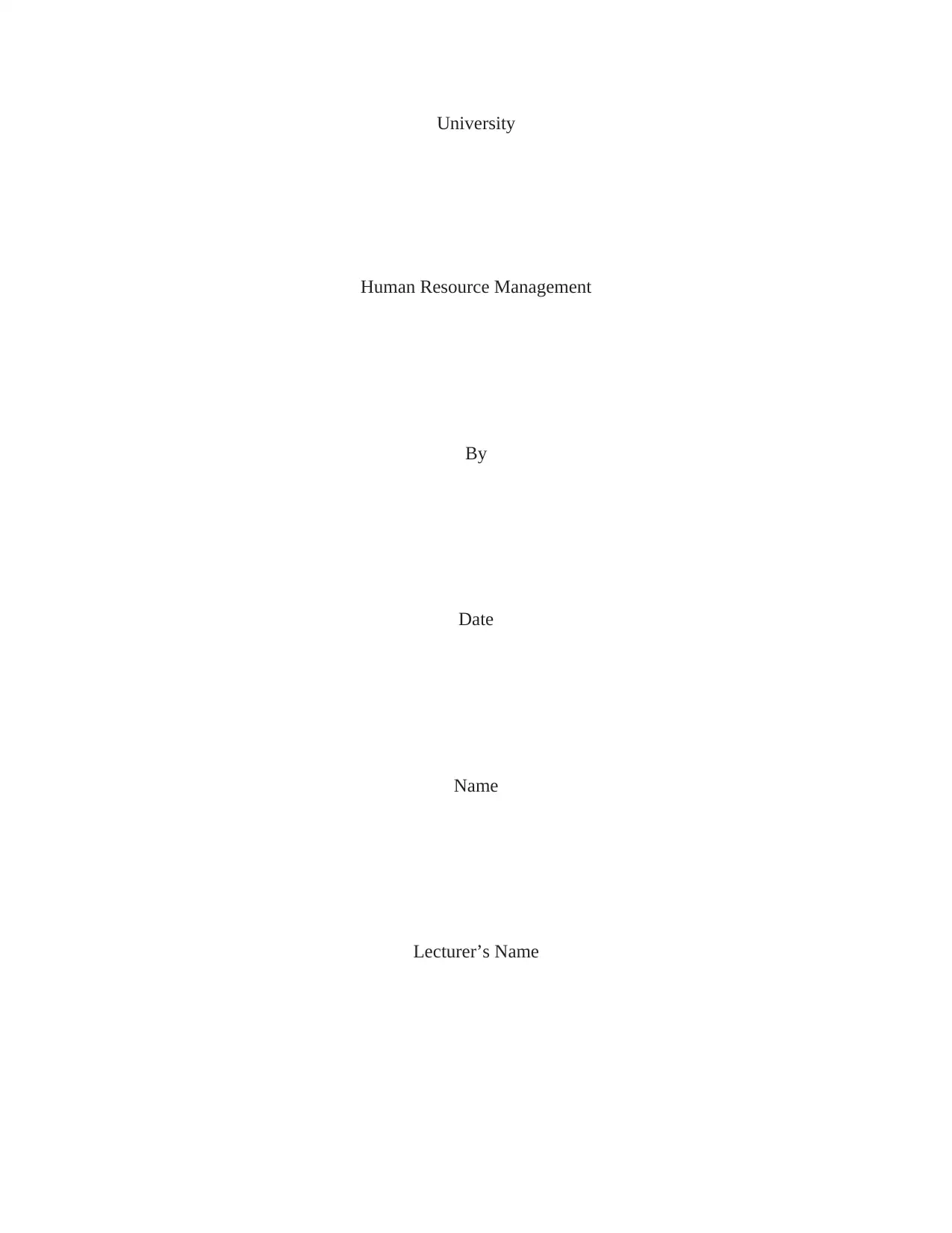
University
Human Resource Management
By
Date
Name
Lecturer’s Name
Human Resource Management
By
Date
Name
Lecturer’s Name
Paraphrase This Document
Need a fresh take? Get an instant paraphrase of this document with our AI Paraphraser
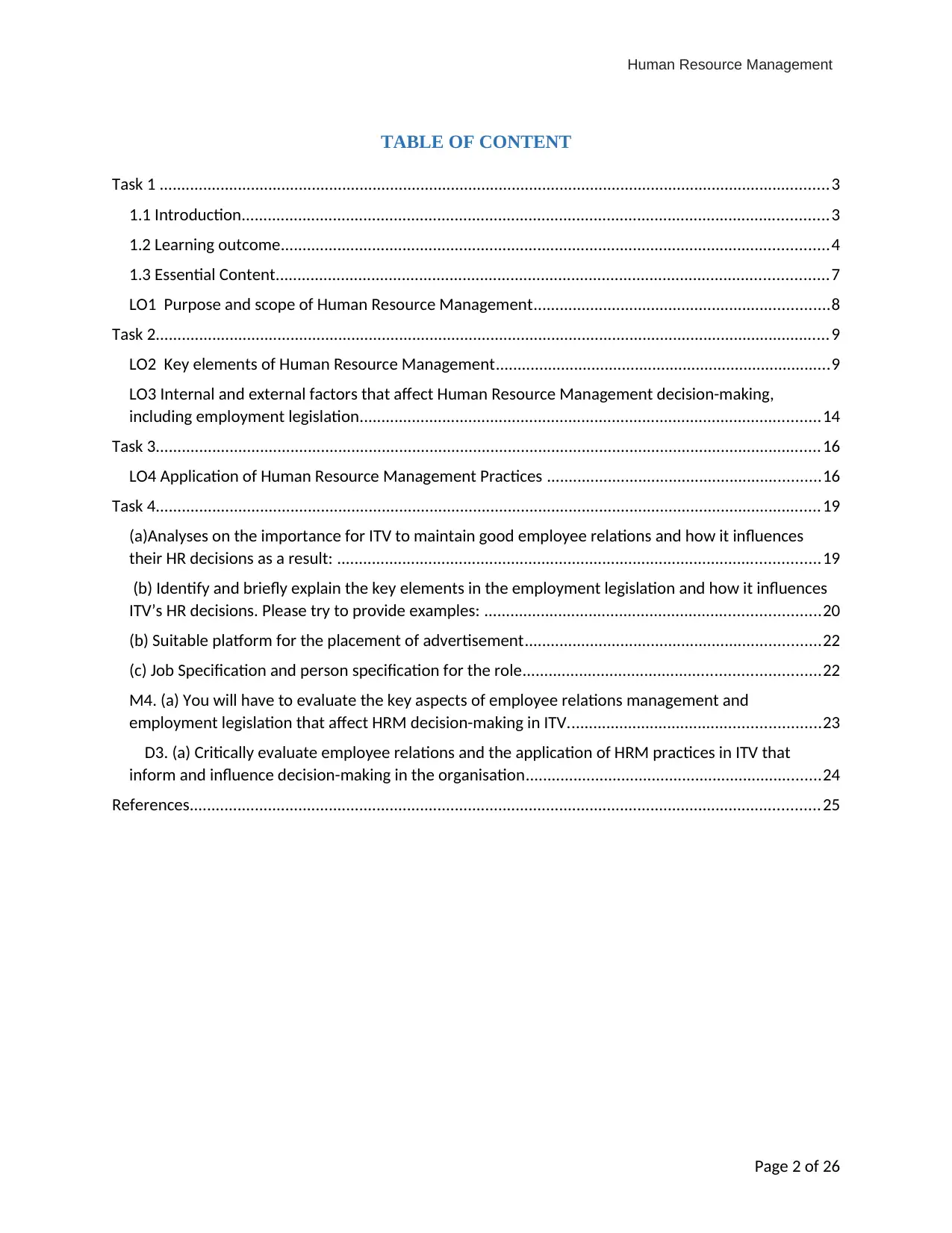
Human Resource Management
TABLE OF CONTENT
Task 1 ..........................................................................................................................................................3
1.1 Introduction.......................................................................................................................................3
1.2 Learning outcome..............................................................................................................................4
1.3 Essential Content...............................................................................................................................7
LO1 Purpose and scope of Human Resource Management....................................................................8
Task 2...........................................................................................................................................................9
LO2 Key elements of Human Resource Management.............................................................................9
LO3 Internal and external factors that affect Human Resource Management decision-making,
including employment legislation..........................................................................................................14
Task 3.........................................................................................................................................................16
LO4 Application of Human Resource Management Practices ...............................................................16
Task 4.........................................................................................................................................................19
(a)Analyses on the importance for ITV to maintain good employee relations and how it influences
their HR decisions as a result: ...............................................................................................................19
(b) Identify and briefly explain the key elements in the employment legislation and how it influences
ITV’s HR decisions. Please try to provide examples: .............................................................................20
(b) Suitable platform for the placement of advertisement....................................................................22
(c) Job Specification and person specification for the role....................................................................22
M4. (a) You will have to evaluate the key aspects of employee relations management and
employment legislation that affect HRM decision-making in ITV..........................................................23
D3. (a) Critically evaluate employee relations and the application of HRM practices in ITV that
inform and influence decision-making in the organisation....................................................................24
References.................................................................................................................................................25
Page 2 of 26
TABLE OF CONTENT
Task 1 ..........................................................................................................................................................3
1.1 Introduction.......................................................................................................................................3
1.2 Learning outcome..............................................................................................................................4
1.3 Essential Content...............................................................................................................................7
LO1 Purpose and scope of Human Resource Management....................................................................8
Task 2...........................................................................................................................................................9
LO2 Key elements of Human Resource Management.............................................................................9
LO3 Internal and external factors that affect Human Resource Management decision-making,
including employment legislation..........................................................................................................14
Task 3.........................................................................................................................................................16
LO4 Application of Human Resource Management Practices ...............................................................16
Task 4.........................................................................................................................................................19
(a)Analyses on the importance for ITV to maintain good employee relations and how it influences
their HR decisions as a result: ...............................................................................................................19
(b) Identify and briefly explain the key elements in the employment legislation and how it influences
ITV’s HR decisions. Please try to provide examples: .............................................................................20
(b) Suitable platform for the placement of advertisement....................................................................22
(c) Job Specification and person specification for the role....................................................................22
M4. (a) You will have to evaluate the key aspects of employee relations management and
employment legislation that affect HRM decision-making in ITV..........................................................23
D3. (a) Critically evaluate employee relations and the application of HRM practices in ITV that
inform and influence decision-making in the organisation....................................................................24
References.................................................................................................................................................25
Page 2 of 26
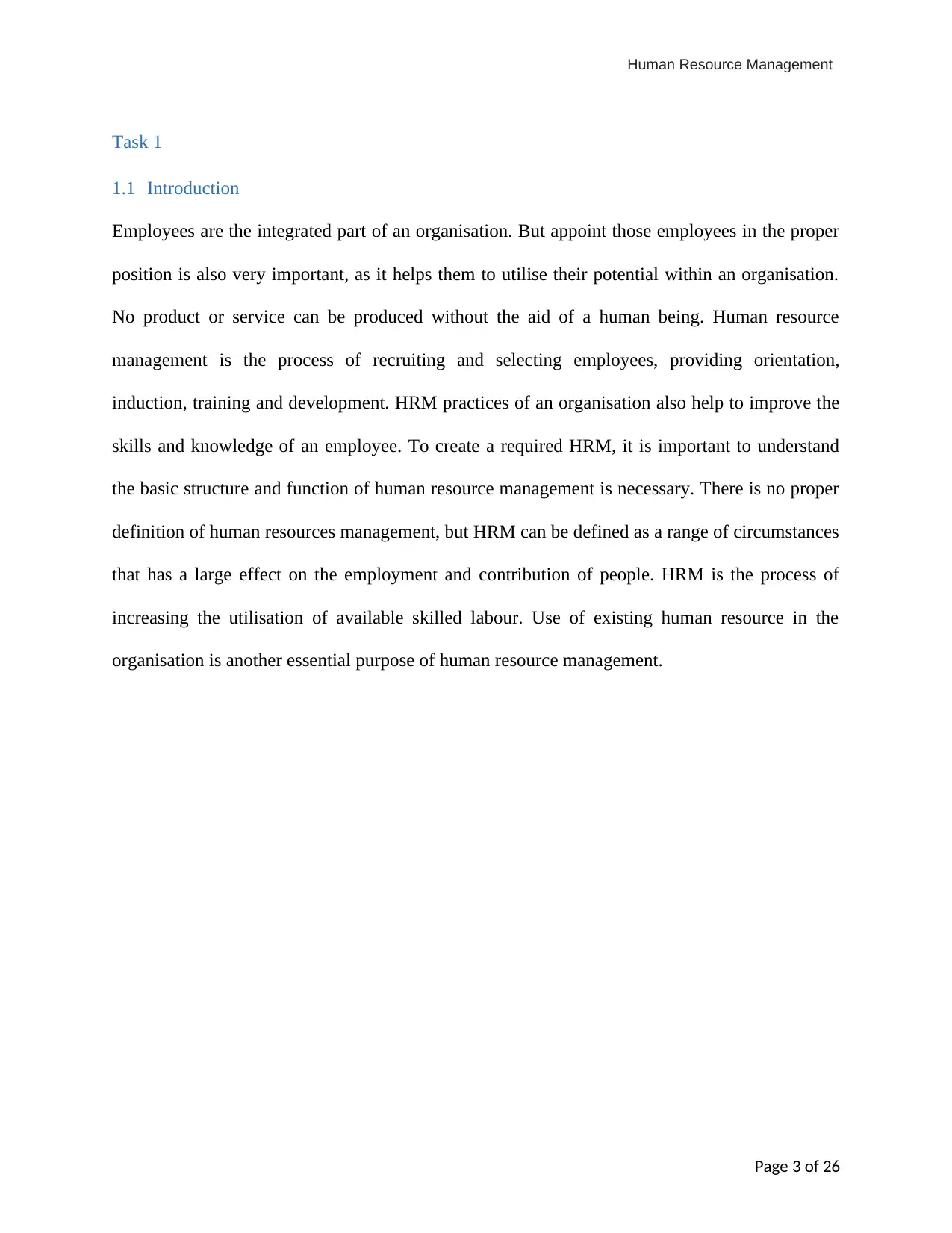
Human Resource Management
Task 1
1.1 Introduction
Employees are the integrated part of an organisation. But appoint those employees in the proper
position is also very important, as it helps them to utilise their potential within an organisation.
No product or service can be produced without the aid of a human being. Human resource
management is the process of recruiting and selecting employees, providing orientation,
induction, training and development. HRM practices of an organisation also help to improve the
skills and knowledge of an employee. To create a required HRM, it is important to understand
the basic structure and function of human resource management is necessary. There is no proper
definition of human resources management, but HRM can be defined as a range of circumstances
that has a large effect on the employment and contribution of people. HRM is the process of
increasing the utilisation of available skilled labour. Use of existing human resource in the
organisation is another essential purpose of human resource management.
Page 3 of 26
Task 1
1.1 Introduction
Employees are the integrated part of an organisation. But appoint those employees in the proper
position is also very important, as it helps them to utilise their potential within an organisation.
No product or service can be produced without the aid of a human being. Human resource
management is the process of recruiting and selecting employees, providing orientation,
induction, training and development. HRM practices of an organisation also help to improve the
skills and knowledge of an employee. To create a required HRM, it is important to understand
the basic structure and function of human resource management is necessary. There is no proper
definition of human resources management, but HRM can be defined as a range of circumstances
that has a large effect on the employment and contribution of people. HRM is the process of
increasing the utilisation of available skilled labour. Use of existing human resource in the
organisation is another essential purpose of human resource management.
Page 3 of 26
⊘ This is a preview!⊘
Do you want full access?
Subscribe today to unlock all pages.

Trusted by 1+ million students worldwide
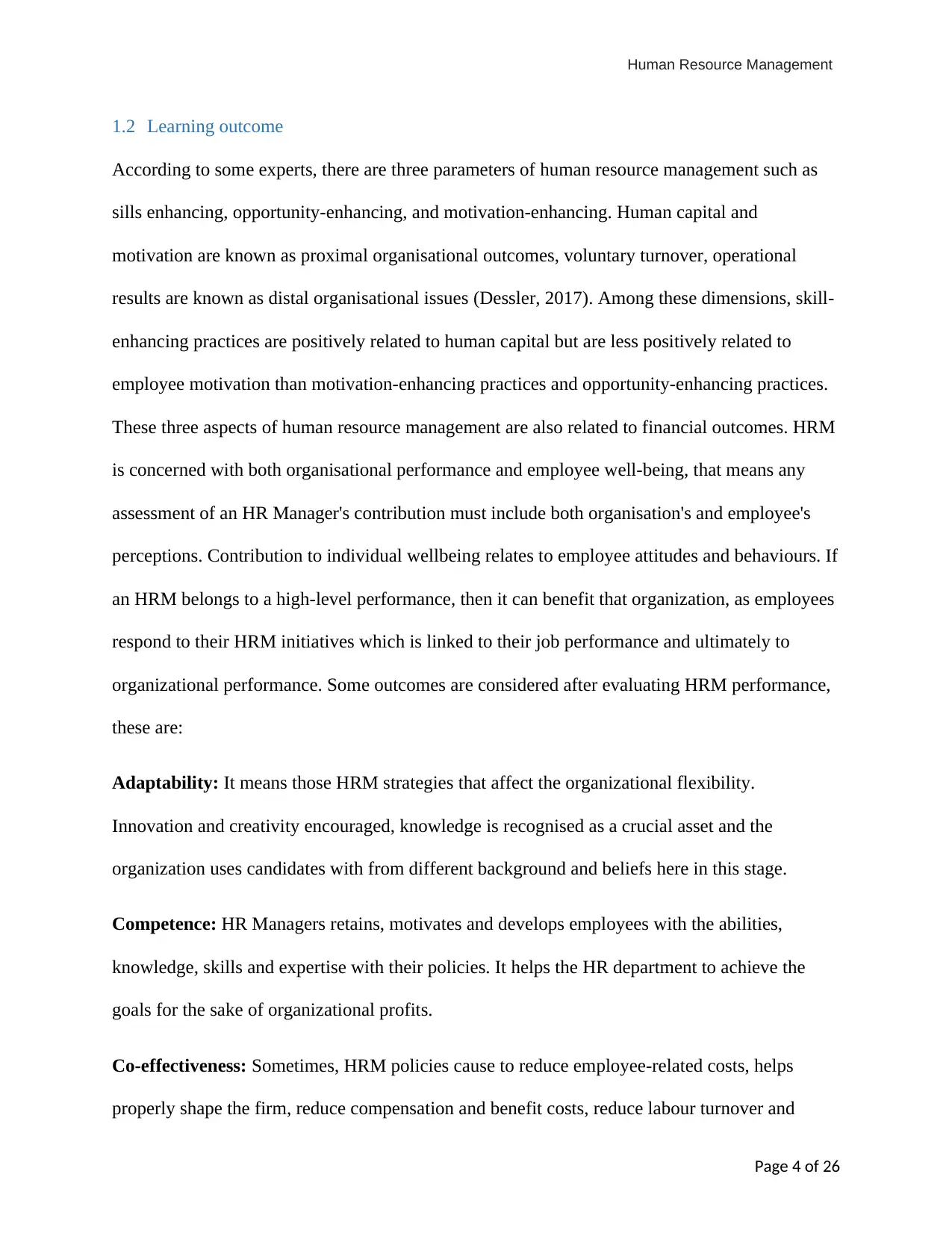
Human Resource Management
1.2 Learning outcome
According to some experts, there are three parameters of human resource management such as
sills enhancing, opportunity-enhancing, and motivation-enhancing. Human capital and
motivation are known as proximal organisational outcomes, voluntary turnover, operational
results are known as distal organisational issues (Dessler, 2017). Among these dimensions, skill-
enhancing practices are positively related to human capital but are less positively related to
employee motivation than motivation-enhancing practices and opportunity-enhancing practices.
These three aspects of human resource management are also related to financial outcomes. HRM
is concerned with both organisational performance and employee well-being, that means any
assessment of an HR Manager's contribution must include both organisation's and employee's
perceptions. Contribution to individual wellbeing relates to employee attitudes and behaviours. If
an HRM belongs to a high-level performance, then it can benefit that organization, as employees
respond to their HRM initiatives which is linked to their job performance and ultimately to
organizational performance. Some outcomes are considered after evaluating HRM performance,
these are:
Adaptability: It means those HRM strategies that affect the organizational flexibility.
Innovation and creativity encouraged, knowledge is recognised as a crucial asset and the
organization uses candidates with from different background and beliefs here in this stage.
Competence: HR Managers retains, motivates and develops employees with the abilities,
knowledge, skills and expertise with their policies. It helps the HR department to achieve the
goals for the sake of organizational profits.
Co-effectiveness: Sometimes, HRM policies cause to reduce employee-related costs, helps
properly shape the firm, reduce compensation and benefit costs, reduce labour turnover and
Page 4 of 26
1.2 Learning outcome
According to some experts, there are three parameters of human resource management such as
sills enhancing, opportunity-enhancing, and motivation-enhancing. Human capital and
motivation are known as proximal organisational outcomes, voluntary turnover, operational
results are known as distal organisational issues (Dessler, 2017). Among these dimensions, skill-
enhancing practices are positively related to human capital but are less positively related to
employee motivation than motivation-enhancing practices and opportunity-enhancing practices.
These three aspects of human resource management are also related to financial outcomes. HRM
is concerned with both organisational performance and employee well-being, that means any
assessment of an HR Manager's contribution must include both organisation's and employee's
perceptions. Contribution to individual wellbeing relates to employee attitudes and behaviours. If
an HRM belongs to a high-level performance, then it can benefit that organization, as employees
respond to their HRM initiatives which is linked to their job performance and ultimately to
organizational performance. Some outcomes are considered after evaluating HRM performance,
these are:
Adaptability: It means those HRM strategies that affect the organizational flexibility.
Innovation and creativity encouraged, knowledge is recognised as a crucial asset and the
organization uses candidates with from different background and beliefs here in this stage.
Competence: HR Managers retains, motivates and develops employees with the abilities,
knowledge, skills and expertise with their policies. It helps the HR department to achieve the
goals for the sake of organizational profits.
Co-effectiveness: Sometimes, HRM policies cause to reduce employee-related costs, helps
properly shape the firm, reduce compensation and benefit costs, reduce labour turnover and
Page 4 of 26
Paraphrase This Document
Need a fresh take? Get an instant paraphrase of this document with our AI Paraphraser
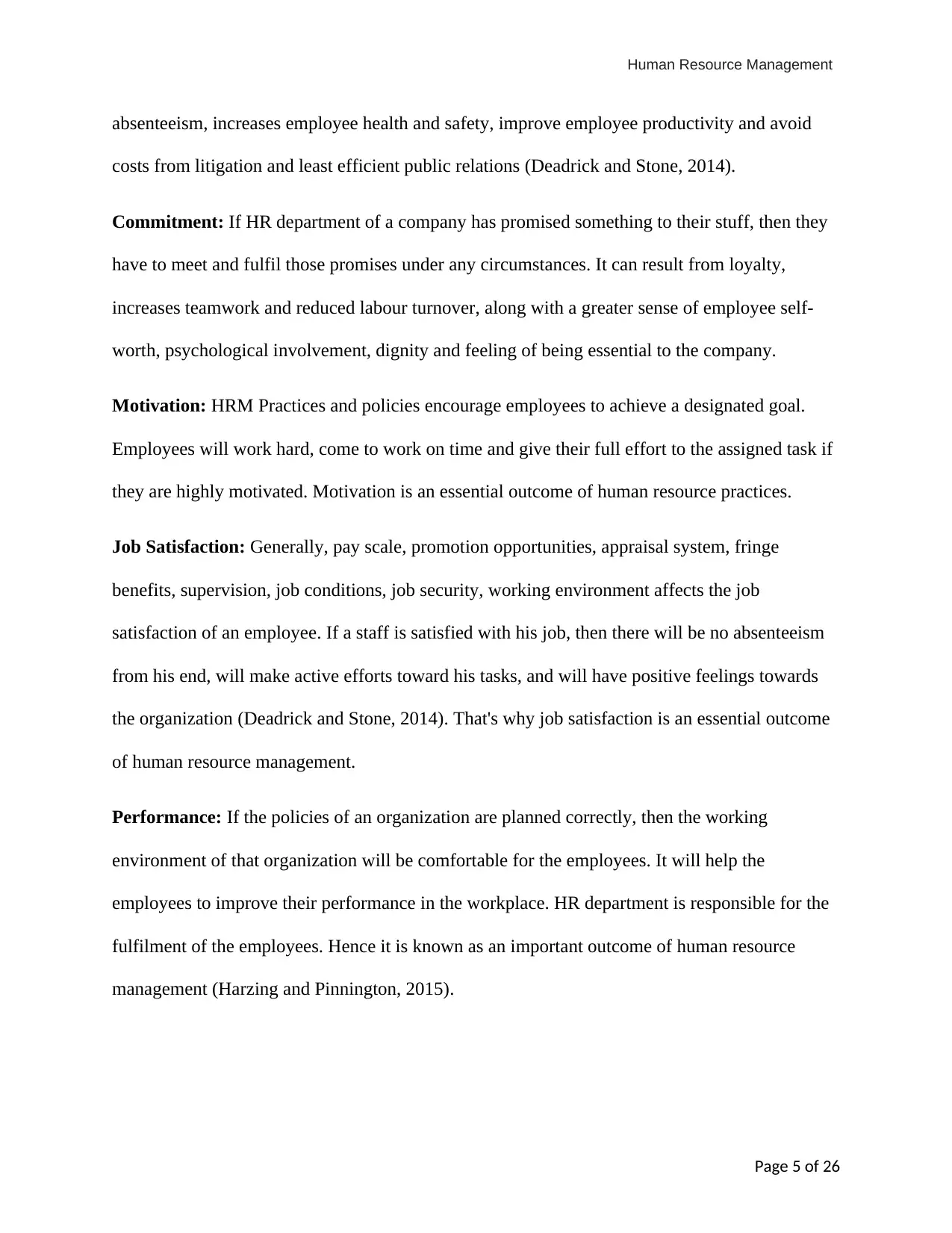
Human Resource Management
absenteeism, increases employee health and safety, improve employee productivity and avoid
costs from litigation and least efficient public relations (Deadrick and Stone, 2014).
Commitment: If HR department of a company has promised something to their stuff, then they
have to meet and fulfil those promises under any circumstances. It can result from loyalty,
increases teamwork and reduced labour turnover, along with a greater sense of employee self-
worth, psychological involvement, dignity and feeling of being essential to the company.
Motivation: HRM Practices and policies encourage employees to achieve a designated goal.
Employees will work hard, come to work on time and give their full effort to the assigned task if
they are highly motivated. Motivation is an essential outcome of human resource practices.
Job Satisfaction: Generally, pay scale, promotion opportunities, appraisal system, fringe
benefits, supervision, job conditions, job security, working environment affects the job
satisfaction of an employee. If a staff is satisfied with his job, then there will be no absenteeism
from his end, will make active efforts toward his tasks, and will have positive feelings towards
the organization (Deadrick and Stone, 2014). That's why job satisfaction is an essential outcome
of human resource management.
Performance: If the policies of an organization are planned correctly, then the working
environment of that organization will be comfortable for the employees. It will help the
employees to improve their performance in the workplace. HR department is responsible for the
fulfilment of the employees. Hence it is known as an important outcome of human resource
management (Harzing and Pinnington, 2015).
Page 5 of 26
absenteeism, increases employee health and safety, improve employee productivity and avoid
costs from litigation and least efficient public relations (Deadrick and Stone, 2014).
Commitment: If HR department of a company has promised something to their stuff, then they
have to meet and fulfil those promises under any circumstances. It can result from loyalty,
increases teamwork and reduced labour turnover, along with a greater sense of employee self-
worth, psychological involvement, dignity and feeling of being essential to the company.
Motivation: HRM Practices and policies encourage employees to achieve a designated goal.
Employees will work hard, come to work on time and give their full effort to the assigned task if
they are highly motivated. Motivation is an essential outcome of human resource practices.
Job Satisfaction: Generally, pay scale, promotion opportunities, appraisal system, fringe
benefits, supervision, job conditions, job security, working environment affects the job
satisfaction of an employee. If a staff is satisfied with his job, then there will be no absenteeism
from his end, will make active efforts toward his tasks, and will have positive feelings towards
the organization (Deadrick and Stone, 2014). That's why job satisfaction is an essential outcome
of human resource management.
Performance: If the policies of an organization are planned correctly, then the working
environment of that organization will be comfortable for the employees. It will help the
employees to improve their performance in the workplace. HR department is responsible for the
fulfilment of the employees. Hence it is known as an important outcome of human resource
management (Harzing and Pinnington, 2015).
Page 5 of 26
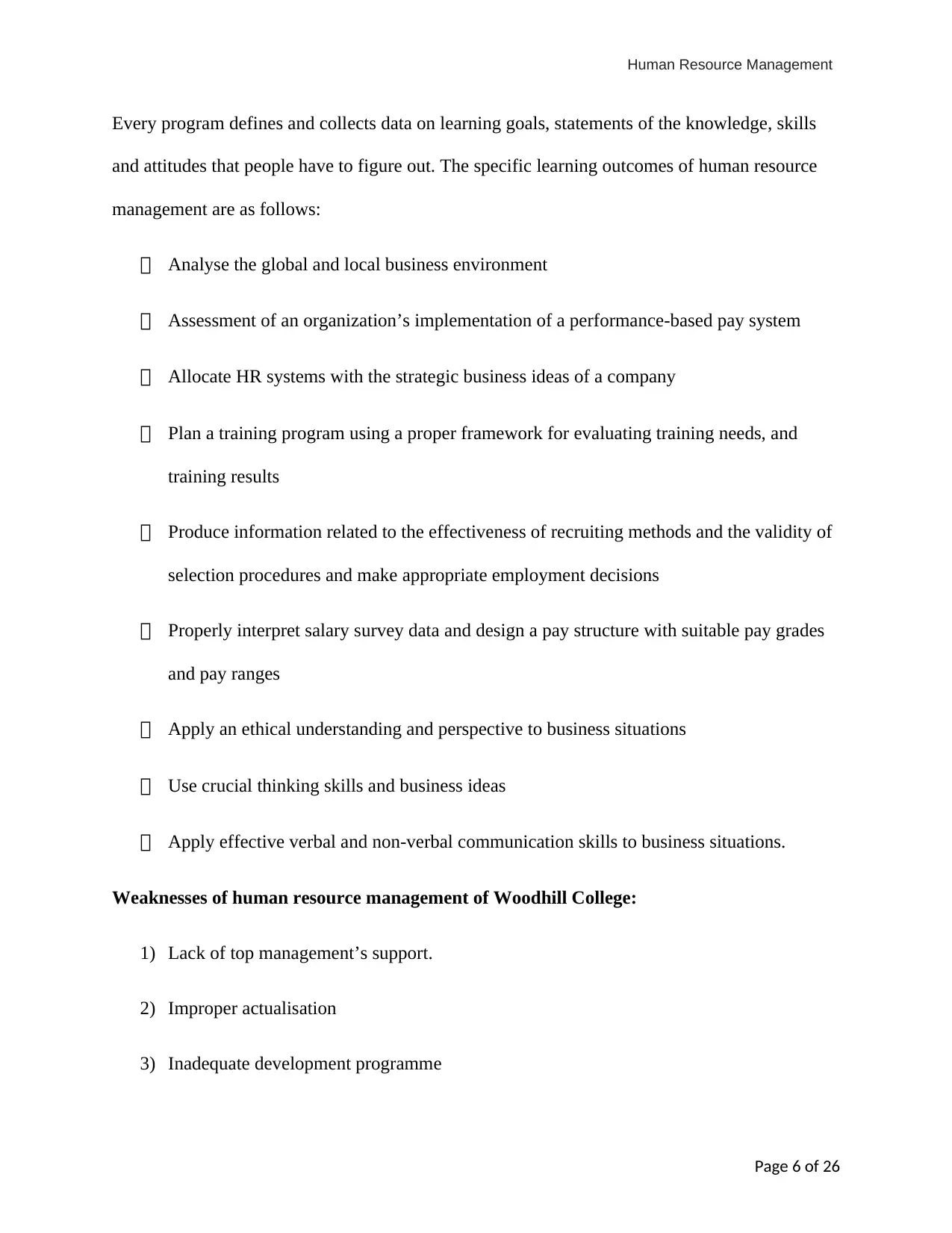
Human Resource Management
Every program defines and collects data on learning goals, statements of the knowledge, skills
and attitudes that people have to figure out. The specific learning outcomes of human resource
management are as follows:
Analyse the global and local business environment
Assessment of an organization’s implementation of a performance-based pay system
Allocate HR systems with the strategic business ideas of a company
Plan a training program using a proper framework for evaluating training needs, and
training results
Produce information related to the effectiveness of recruiting methods and the validity of
selection procedures and make appropriate employment decisions
Properly interpret salary survey data and design a pay structure with suitable pay grades
and pay ranges
Apply an ethical understanding and perspective to business situations
Use crucial thinking skills and business ideas
Apply effective verbal and non-verbal communication skills to business situations.
Weaknesses of human resource management of Woodhill College:
1) Lack of top management’s support.
2) Improper actualisation
3) Inadequate development programme
Page 6 of 26
Every program defines and collects data on learning goals, statements of the knowledge, skills
and attitudes that people have to figure out. The specific learning outcomes of human resource
management are as follows:
Analyse the global and local business environment
Assessment of an organization’s implementation of a performance-based pay system
Allocate HR systems with the strategic business ideas of a company
Plan a training program using a proper framework for evaluating training needs, and
training results
Produce information related to the effectiveness of recruiting methods and the validity of
selection procedures and make appropriate employment decisions
Properly interpret salary survey data and design a pay structure with suitable pay grades
and pay ranges
Apply an ethical understanding and perspective to business situations
Use crucial thinking skills and business ideas
Apply effective verbal and non-verbal communication skills to business situations.
Weaknesses of human resource management of Woodhill College:
1) Lack of top management’s support.
2) Improper actualisation
3) Inadequate development programme
Page 6 of 26
⊘ This is a preview!⊘
Do you want full access?
Subscribe today to unlock all pages.

Trusted by 1+ million students worldwide
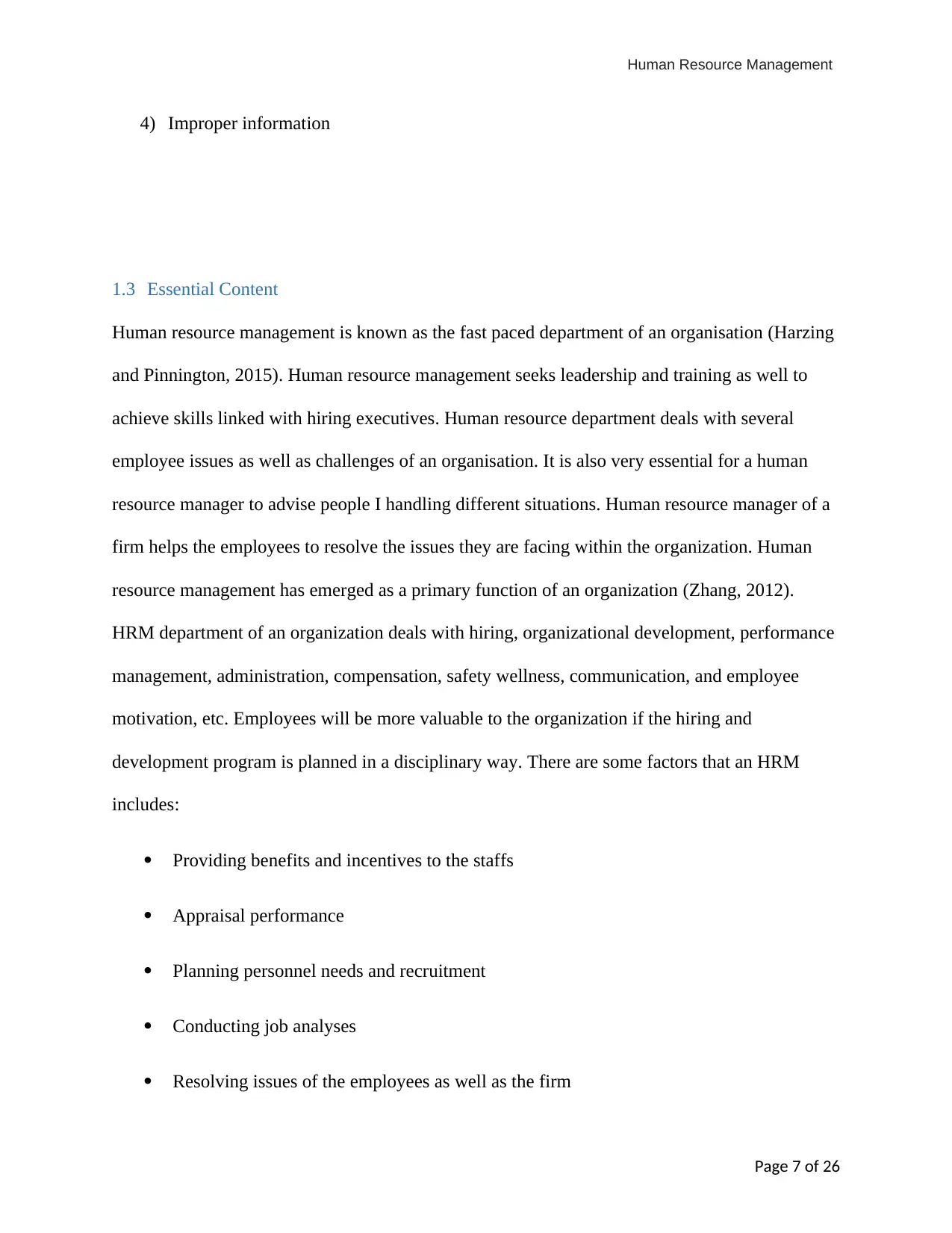
Human Resource Management
4) Improper information
1.3 Essential Content
Human resource management is known as the fast paced department of an organisation (Harzing
and Pinnington, 2015). Human resource management seeks leadership and training as well to
achieve skills linked with hiring executives. Human resource department deals with several
employee issues as well as challenges of an organisation. It is also very essential for a human
resource manager to advise people I handling different situations. Human resource manager of a
firm helps the employees to resolve the issues they are facing within the organization. Human
resource management has emerged as a primary function of an organization (Zhang, 2012).
HRM department of an organization deals with hiring, organizational development, performance
management, administration, compensation, safety wellness, communication, and employee
motivation, etc. Employees will be more valuable to the organization if the hiring and
development program is planned in a disciplinary way. There are some factors that an HRM
includes:
Providing benefits and incentives to the staffs
Appraisal performance
Planning personnel needs and recruitment
Conducting job analyses
Resolving issues of the employees as well as the firm
Page 7 of 26
4) Improper information
1.3 Essential Content
Human resource management is known as the fast paced department of an organisation (Harzing
and Pinnington, 2015). Human resource management seeks leadership and training as well to
achieve skills linked with hiring executives. Human resource department deals with several
employee issues as well as challenges of an organisation. It is also very essential for a human
resource manager to advise people I handling different situations. Human resource manager of a
firm helps the employees to resolve the issues they are facing within the organization. Human
resource management has emerged as a primary function of an organization (Zhang, 2012).
HRM department of an organization deals with hiring, organizational development, performance
management, administration, compensation, safety wellness, communication, and employee
motivation, etc. Employees will be more valuable to the organization if the hiring and
development program is planned in a disciplinary way. There are some factors that an HRM
includes:
Providing benefits and incentives to the staffs
Appraisal performance
Planning personnel needs and recruitment
Conducting job analyses
Resolving issues of the employees as well as the firm
Page 7 of 26
Paraphrase This Document
Need a fresh take? Get an instant paraphrase of this document with our AI Paraphraser
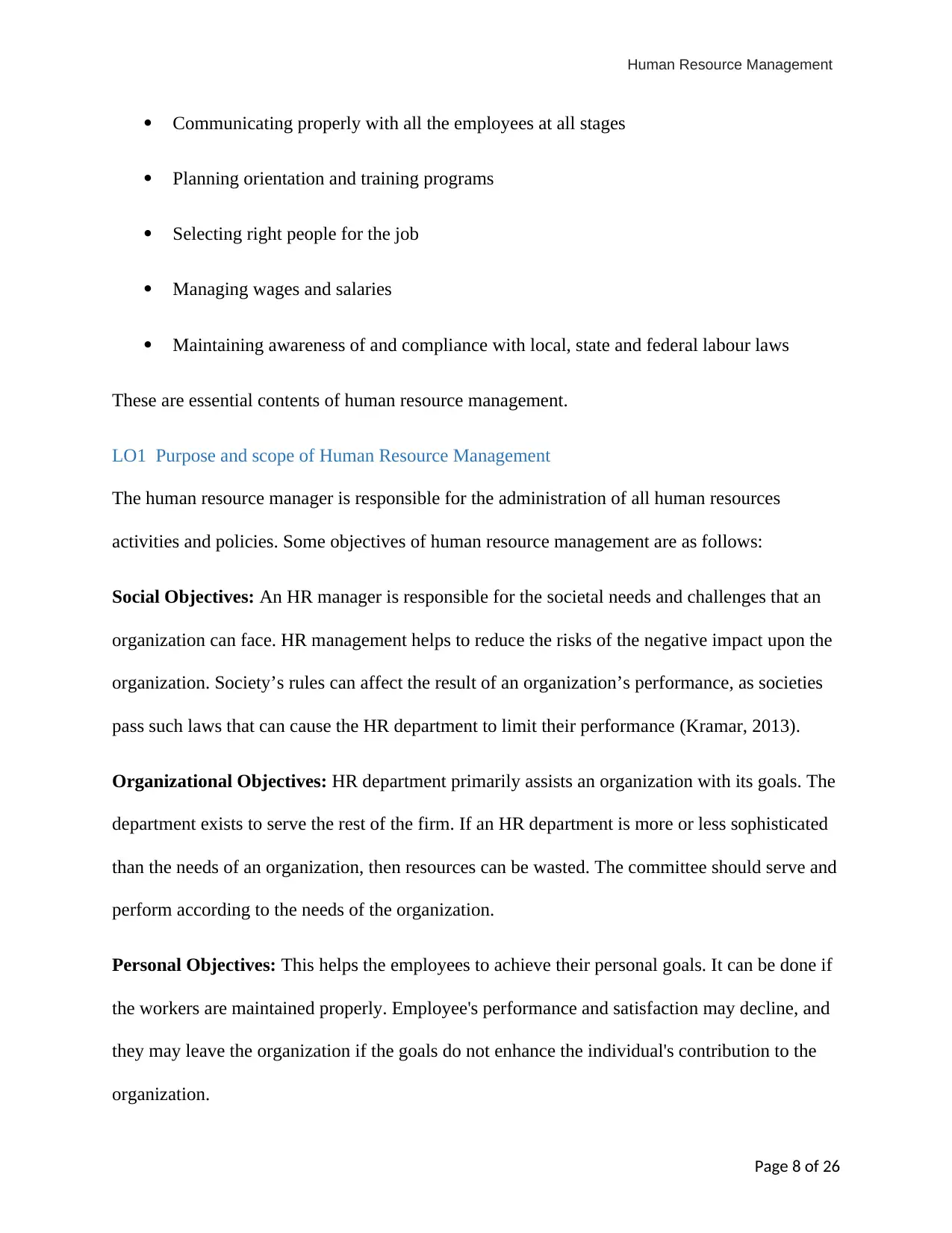
Human Resource Management
Communicating properly with all the employees at all stages
Planning orientation and training programs
Selecting right people for the job
Managing wages and salaries
Maintaining awareness of and compliance with local, state and federal labour laws
These are essential contents of human resource management.
LO1 Purpose and scope of Human Resource Management
The human resource manager is responsible for the administration of all human resources
activities and policies. Some objectives of human resource management are as follows:
Social Objectives: An HR manager is responsible for the societal needs and challenges that an
organization can face. HR management helps to reduce the risks of the negative impact upon the
organization. Society’s rules can affect the result of an organization’s performance, as societies
pass such laws that can cause the HR department to limit their performance (Kramar, 2013).
Organizational Objectives: HR department primarily assists an organization with its goals. The
department exists to serve the rest of the firm. If an HR department is more or less sophisticated
than the needs of an organization, then resources can be wasted. The committee should serve and
perform according to the needs of the organization.
Personal Objectives: This helps the employees to achieve their personal goals. It can be done if
the workers are maintained properly. Employee's performance and satisfaction may decline, and
they may leave the organization if the goals do not enhance the individual's contribution to the
organization.
Page 8 of 26
Communicating properly with all the employees at all stages
Planning orientation and training programs
Selecting right people for the job
Managing wages and salaries
Maintaining awareness of and compliance with local, state and federal labour laws
These are essential contents of human resource management.
LO1 Purpose and scope of Human Resource Management
The human resource manager is responsible for the administration of all human resources
activities and policies. Some objectives of human resource management are as follows:
Social Objectives: An HR manager is responsible for the societal needs and challenges that an
organization can face. HR management helps to reduce the risks of the negative impact upon the
organization. Society’s rules can affect the result of an organization’s performance, as societies
pass such laws that can cause the HR department to limit their performance (Kramar, 2013).
Organizational Objectives: HR department primarily assists an organization with its goals. The
department exists to serve the rest of the firm. If an HR department is more or less sophisticated
than the needs of an organization, then resources can be wasted. The committee should serve and
perform according to the needs of the organization.
Personal Objectives: This helps the employees to achieve their personal goals. It can be done if
the workers are maintained properly. Employee's performance and satisfaction may decline, and
they may leave the organization if the goals do not enhance the individual's contribution to the
organization.
Page 8 of 26
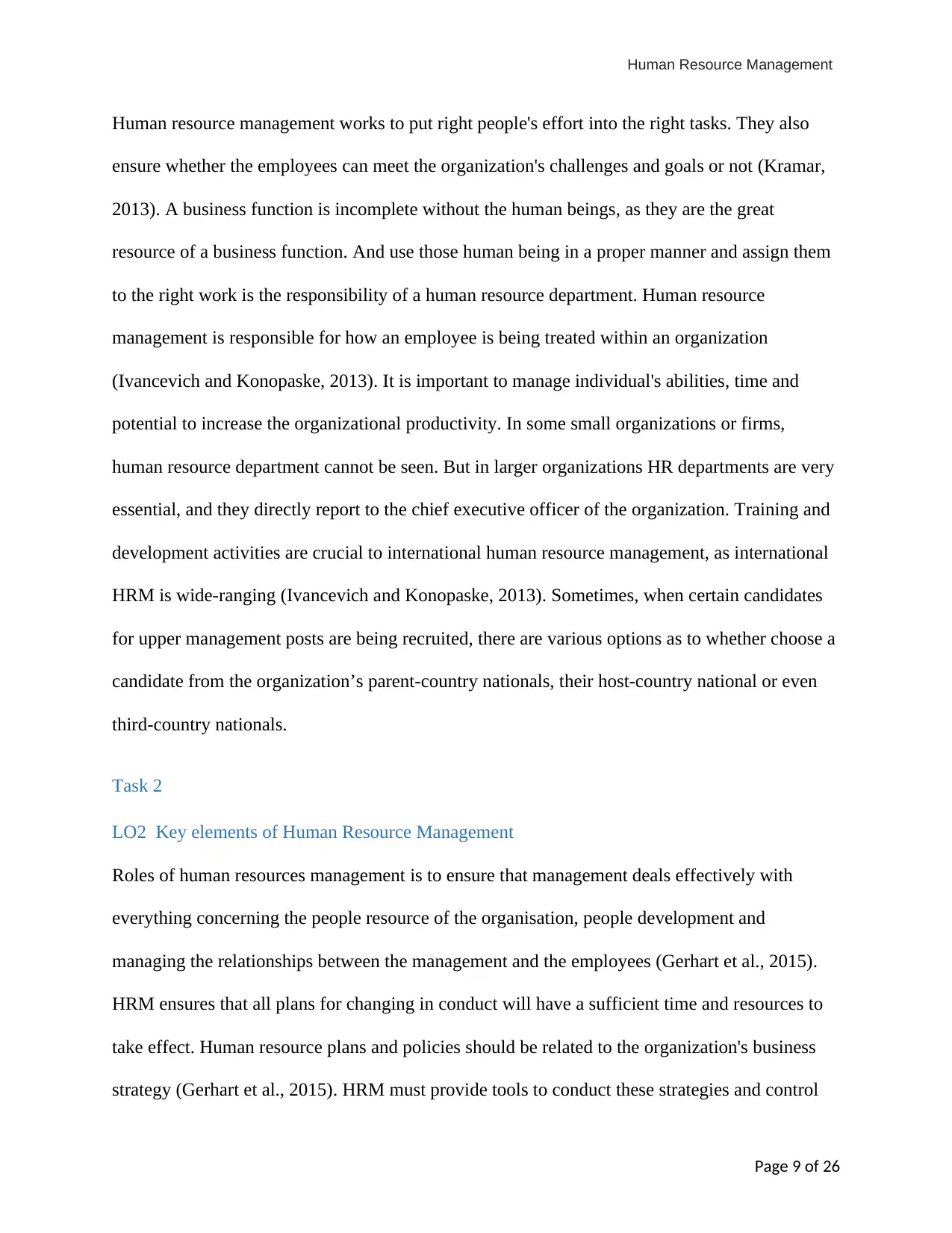
Human Resource Management
Human resource management works to put right people's effort into the right tasks. They also
ensure whether the employees can meet the organization's challenges and goals or not (Kramar,
2013). A business function is incomplete without the human beings, as they are the great
resource of a business function. And use those human being in a proper manner and assign them
to the right work is the responsibility of a human resource department. Human resource
management is responsible for how an employee is being treated within an organization
(Ivancevich and Konopaske, 2013). It is important to manage individual's abilities, time and
potential to increase the organizational productivity. In some small organizations or firms,
human resource department cannot be seen. But in larger organizations HR departments are very
essential, and they directly report to the chief executive officer of the organization. Training and
development activities are crucial to international human resource management, as international
HRM is wide-ranging (Ivancevich and Konopaske, 2013). Sometimes, when certain candidates
for upper management posts are being recruited, there are various options as to whether choose a
candidate from the organization’s parent-country nationals, their host-country national or even
third-country nationals.
Task 2
LO2 Key elements of Human Resource Management
Roles of human resources management is to ensure that management deals effectively with
everything concerning the people resource of the organisation, people development and
managing the relationships between the management and the employees (Gerhart et al., 2015).
HRM ensures that all plans for changing in conduct will have a sufficient time and resources to
take effect. Human resource plans and policies should be related to the organization's business
strategy (Gerhart et al., 2015). HRM must provide tools to conduct these strategies and control
Page 9 of 26
Human resource management works to put right people's effort into the right tasks. They also
ensure whether the employees can meet the organization's challenges and goals or not (Kramar,
2013). A business function is incomplete without the human beings, as they are the great
resource of a business function. And use those human being in a proper manner and assign them
to the right work is the responsibility of a human resource department. Human resource
management is responsible for how an employee is being treated within an organization
(Ivancevich and Konopaske, 2013). It is important to manage individual's abilities, time and
potential to increase the organizational productivity. In some small organizations or firms,
human resource department cannot be seen. But in larger organizations HR departments are very
essential, and they directly report to the chief executive officer of the organization. Training and
development activities are crucial to international human resource management, as international
HRM is wide-ranging (Ivancevich and Konopaske, 2013). Sometimes, when certain candidates
for upper management posts are being recruited, there are various options as to whether choose a
candidate from the organization’s parent-country nationals, their host-country national or even
third-country nationals.
Task 2
LO2 Key elements of Human Resource Management
Roles of human resources management is to ensure that management deals effectively with
everything concerning the people resource of the organisation, people development and
managing the relationships between the management and the employees (Gerhart et al., 2015).
HRM ensures that all plans for changing in conduct will have a sufficient time and resources to
take effect. Human resource plans and policies should be related to the organization's business
strategy (Gerhart et al., 2015). HRM must provide tools to conduct these strategies and control
Page 9 of 26
⊘ This is a preview!⊘
Do you want full access?
Subscribe today to unlock all pages.

Trusted by 1+ million students worldwide
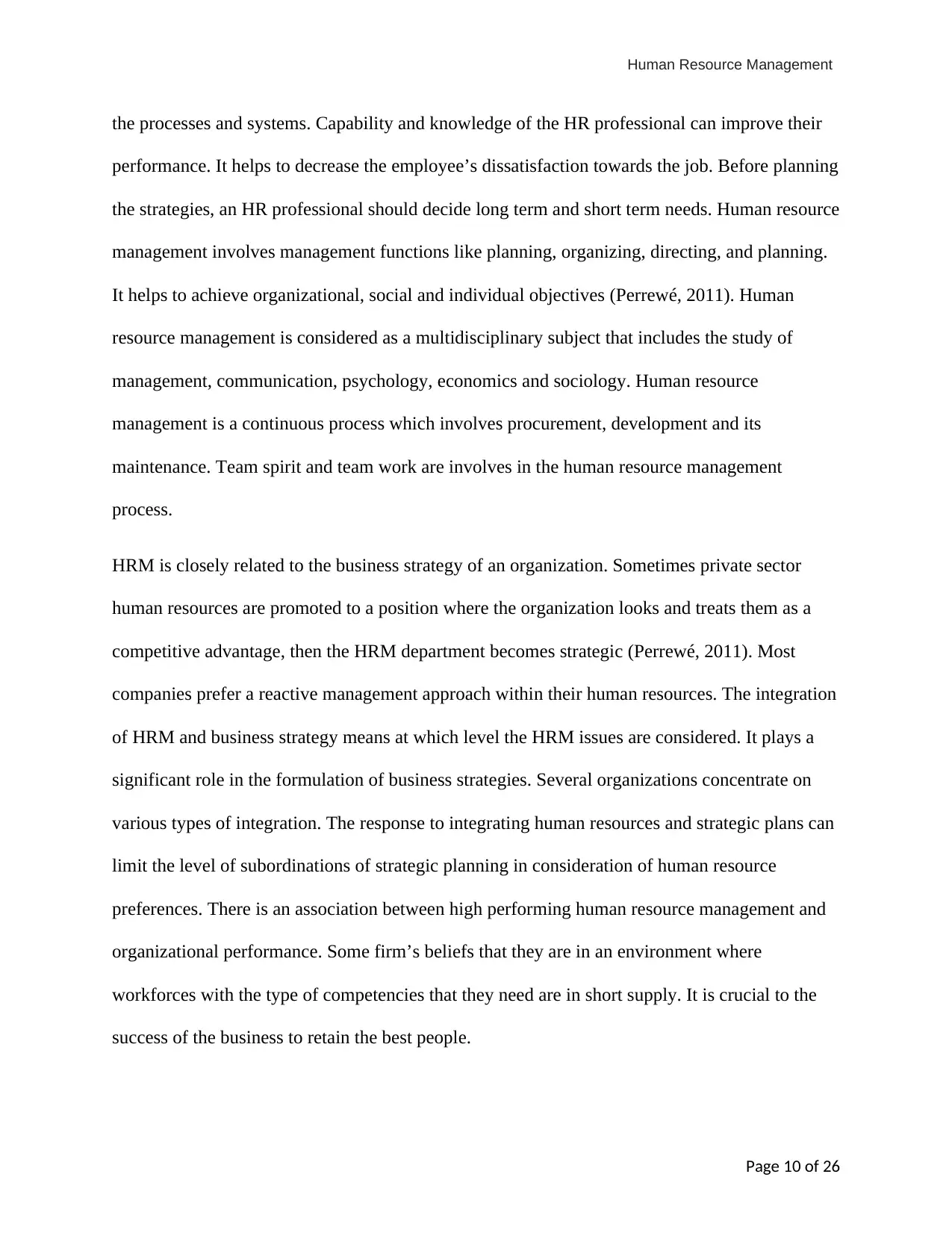
Human Resource Management
the processes and systems. Capability and knowledge of the HR professional can improve their
performance. It helps to decrease the employee’s dissatisfaction towards the job. Before planning
the strategies, an HR professional should decide long term and short term needs. Human resource
management involves management functions like planning, organizing, directing, and planning.
It helps to achieve organizational, social and individual objectives (Perrewé, 2011). Human
resource management is considered as a multidisciplinary subject that includes the study of
management, communication, psychology, economics and sociology. Human resource
management is a continuous process which involves procurement, development and its
maintenance. Team spirit and team work are involves in the human resource management
process.
HRM is closely related to the business strategy of an organization. Sometimes private sector
human resources are promoted to a position where the organization looks and treats them as a
competitive advantage, then the HRM department becomes strategic (Perrewé, 2011). Most
companies prefer a reactive management approach within their human resources. The integration
of HRM and business strategy means at which level the HRM issues are considered. It plays a
significant role in the formulation of business strategies. Several organizations concentrate on
various types of integration. The response to integrating human resources and strategic plans can
limit the level of subordinations of strategic planning in consideration of human resource
preferences. There is an association between high performing human resource management and
organizational performance. Some firm’s beliefs that they are in an environment where
workforces with the type of competencies that they need are in short supply. It is crucial to the
success of the business to retain the best people.
Page 10 of 26
the processes and systems. Capability and knowledge of the HR professional can improve their
performance. It helps to decrease the employee’s dissatisfaction towards the job. Before planning
the strategies, an HR professional should decide long term and short term needs. Human resource
management involves management functions like planning, organizing, directing, and planning.
It helps to achieve organizational, social and individual objectives (Perrewé, 2011). Human
resource management is considered as a multidisciplinary subject that includes the study of
management, communication, psychology, economics and sociology. Human resource
management is a continuous process which involves procurement, development and its
maintenance. Team spirit and team work are involves in the human resource management
process.
HRM is closely related to the business strategy of an organization. Sometimes private sector
human resources are promoted to a position where the organization looks and treats them as a
competitive advantage, then the HRM department becomes strategic (Perrewé, 2011). Most
companies prefer a reactive management approach within their human resources. The integration
of HRM and business strategy means at which level the HRM issues are considered. It plays a
significant role in the formulation of business strategies. Several organizations concentrate on
various types of integration. The response to integrating human resources and strategic plans can
limit the level of subordinations of strategic planning in consideration of human resource
preferences. There is an association between high performing human resource management and
organizational performance. Some firm’s beliefs that they are in an environment where
workforces with the type of competencies that they need are in short supply. It is crucial to the
success of the business to retain the best people.
Page 10 of 26
Paraphrase This Document
Need a fresh take? Get an instant paraphrase of this document with our AI Paraphraser
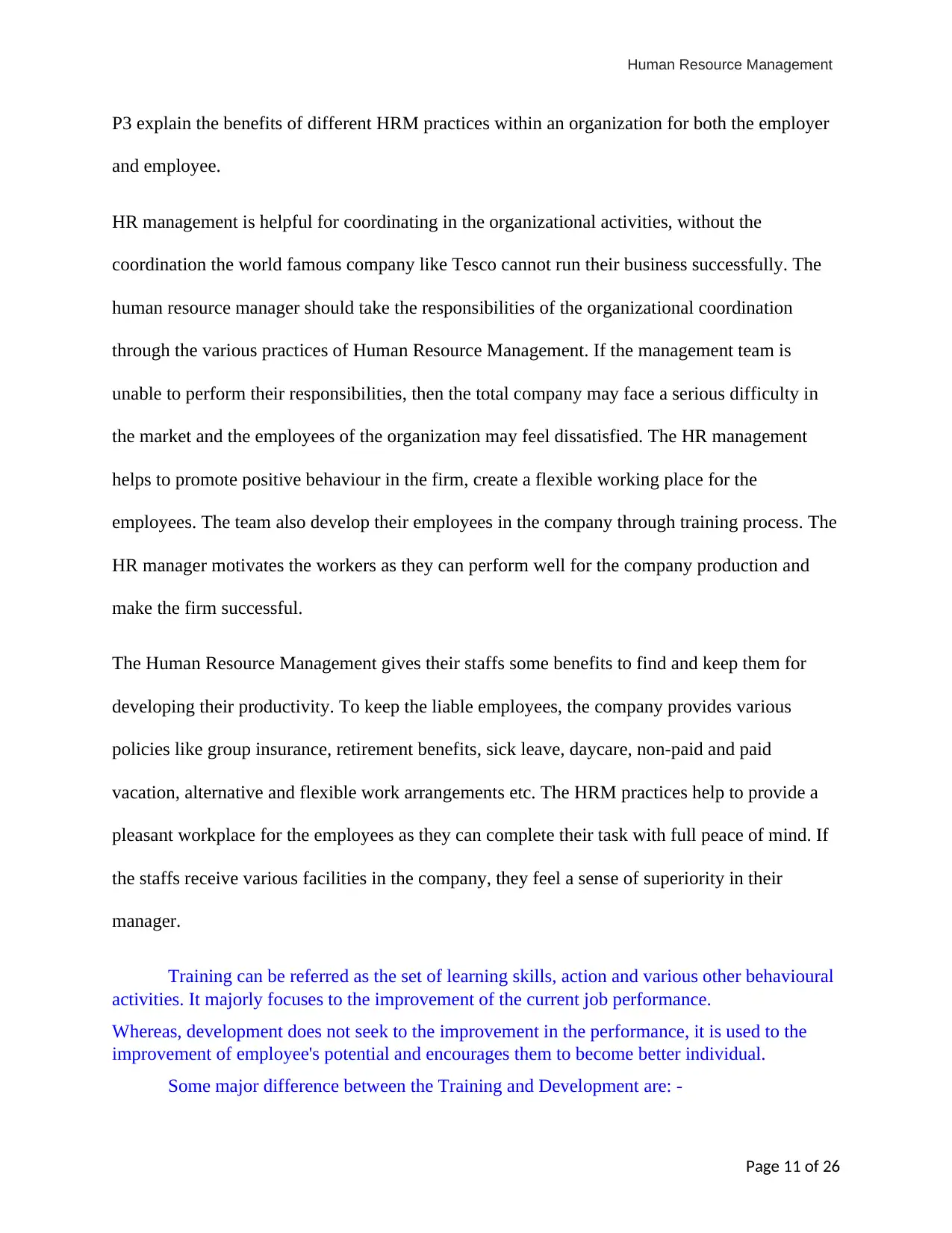
Human Resource Management
P3 explain the benefits of different HRM practices within an organization for both the employer
and employee.
HR management is helpful for coordinating in the organizational activities, without the
coordination the world famous company like Tesco cannot run their business successfully. The
human resource manager should take the responsibilities of the organizational coordination
through the various practices of Human Resource Management. If the management team is
unable to perform their responsibilities, then the total company may face a serious difficulty in
the market and the employees of the organization may feel dissatisfied. The HR management
helps to promote positive behaviour in the firm, create a flexible working place for the
employees. The team also develop their employees in the company through training process. The
HR manager motivates the workers as they can perform well for the company production and
make the firm successful.
The Human Resource Management gives their staffs some benefits to find and keep them for
developing their productivity. To keep the liable employees, the company provides various
policies like group insurance, retirement benefits, sick leave, daycare, non-paid and paid
vacation, alternative and flexible work arrangements etc. The HRM practices help to provide a
pleasant workplace for the employees as they can complete their task with full peace of mind. If
the staffs receive various facilities in the company, they feel a sense of superiority in their
manager.
Training can be referred as the set of learning skills, action and various other behavioural
activities. It majorly focuses to the improvement of the current job performance.
Whereas, development does not seek to the improvement in the performance, it is used to the
improvement of employee's potential and encourages them to become better individual.
Some major difference between the Training and Development are: -
Page 11 of 26
P3 explain the benefits of different HRM practices within an organization for both the employer
and employee.
HR management is helpful for coordinating in the organizational activities, without the
coordination the world famous company like Tesco cannot run their business successfully. The
human resource manager should take the responsibilities of the organizational coordination
through the various practices of Human Resource Management. If the management team is
unable to perform their responsibilities, then the total company may face a serious difficulty in
the market and the employees of the organization may feel dissatisfied. The HR management
helps to promote positive behaviour in the firm, create a flexible working place for the
employees. The team also develop their employees in the company through training process. The
HR manager motivates the workers as they can perform well for the company production and
make the firm successful.
The Human Resource Management gives their staffs some benefits to find and keep them for
developing their productivity. To keep the liable employees, the company provides various
policies like group insurance, retirement benefits, sick leave, daycare, non-paid and paid
vacation, alternative and flexible work arrangements etc. The HRM practices help to provide a
pleasant workplace for the employees as they can complete their task with full peace of mind. If
the staffs receive various facilities in the company, they feel a sense of superiority in their
manager.
Training can be referred as the set of learning skills, action and various other behavioural
activities. It majorly focuses to the improvement of the current job performance.
Whereas, development does not seek to the improvement in the performance, it is used to the
improvement of employee's potential and encourages them to become better individual.
Some major difference between the Training and Development are: -
Page 11 of 26
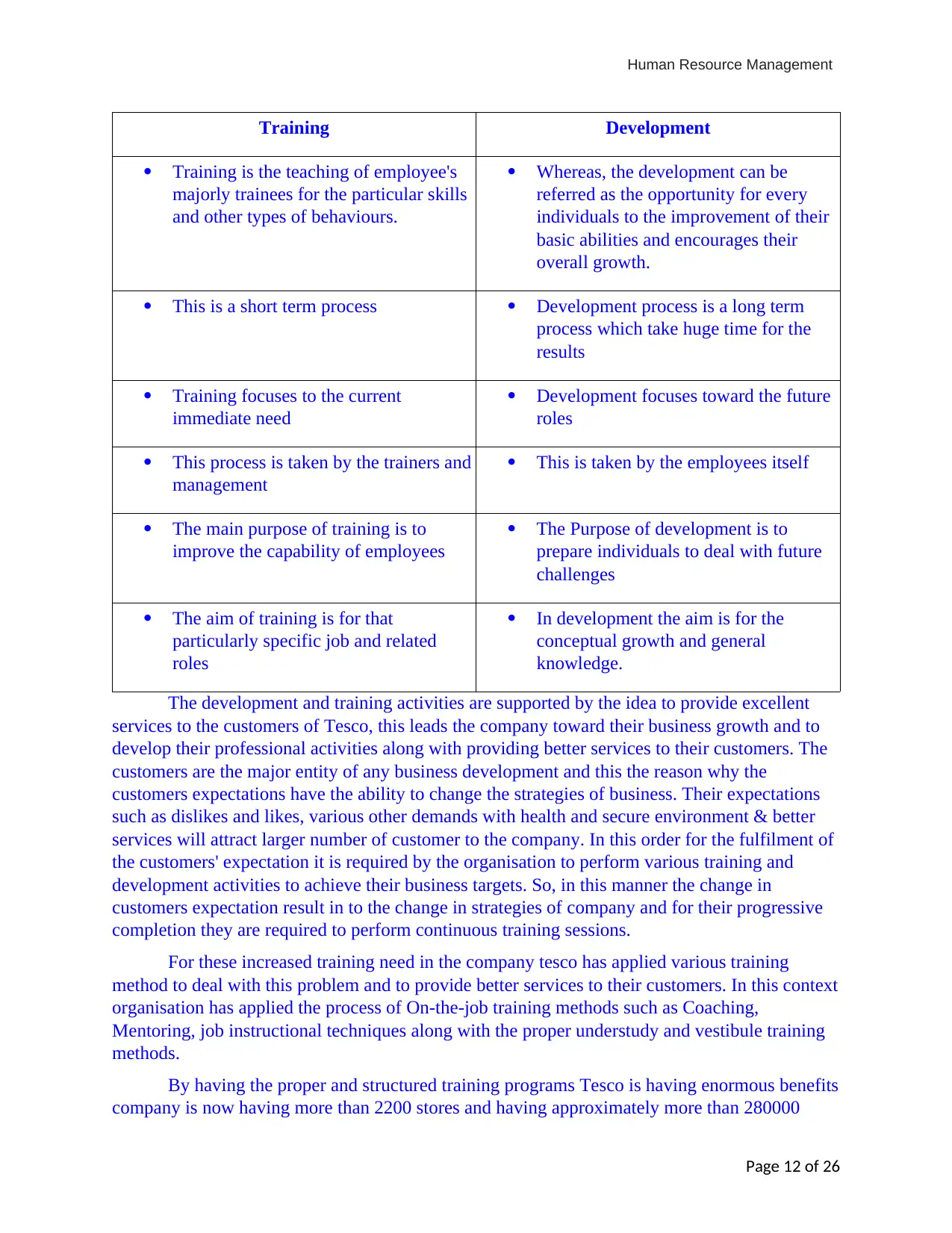
Human Resource Management
Training Development
Training is the teaching of employee's
majorly trainees for the particular skills
and other types of behaviours.
Whereas, the development can be
referred as the opportunity for every
individuals to the improvement of their
basic abilities and encourages their
overall growth.
This is a short term process Development process is a long term
process which take huge time for the
results
Training focuses to the current
immediate need
Development focuses toward the future
roles
This process is taken by the trainers and
management
This is taken by the employees itself
The main purpose of training is to
improve the capability of employees
The Purpose of development is to
prepare individuals to deal with future
challenges
The aim of training is for that
particularly specific job and related
roles
In development the aim is for the
conceptual growth and general
knowledge.
The development and training activities are supported by the idea to provide excellent
services to the customers of Tesco, this leads the company toward their business growth and to
develop their professional activities along with providing better services to their customers. The
customers are the major entity of any business development and this the reason why the
customers expectations have the ability to change the strategies of business. Their expectations
such as dislikes and likes, various other demands with health and secure environment & better
services will attract larger number of customer to the company. In this order for the fulfilment of
the customers' expectation it is required by the organisation to perform various training and
development activities to achieve their business targets. So, in this manner the change in
customers expectation result in to the change in strategies of company and for their progressive
completion they are required to perform continuous training sessions.
For these increased training need in the company tesco has applied various training
method to deal with this problem and to provide better services to their customers. In this context
organisation has applied the process of On-the-job training methods such as Coaching,
Mentoring, job instructional techniques along with the proper understudy and vestibule training
methods.
By having the proper and structured training programs Tesco is having enormous benefits
company is now having more than 2200 stores and having approximately more than 280000
Page 12 of 26
Training Development
Training is the teaching of employee's
majorly trainees for the particular skills
and other types of behaviours.
Whereas, the development can be
referred as the opportunity for every
individuals to the improvement of their
basic abilities and encourages their
overall growth.
This is a short term process Development process is a long term
process which take huge time for the
results
Training focuses to the current
immediate need
Development focuses toward the future
roles
This process is taken by the trainers and
management
This is taken by the employees itself
The main purpose of training is to
improve the capability of employees
The Purpose of development is to
prepare individuals to deal with future
challenges
The aim of training is for that
particularly specific job and related
roles
In development the aim is for the
conceptual growth and general
knowledge.
The development and training activities are supported by the idea to provide excellent
services to the customers of Tesco, this leads the company toward their business growth and to
develop their professional activities along with providing better services to their customers. The
customers are the major entity of any business development and this the reason why the
customers expectations have the ability to change the strategies of business. Their expectations
such as dislikes and likes, various other demands with health and secure environment & better
services will attract larger number of customer to the company. In this order for the fulfilment of
the customers' expectation it is required by the organisation to perform various training and
development activities to achieve their business targets. So, in this manner the change in
customers expectation result in to the change in strategies of company and for their progressive
completion they are required to perform continuous training sessions.
For these increased training need in the company tesco has applied various training
method to deal with this problem and to provide better services to their customers. In this context
organisation has applied the process of On-the-job training methods such as Coaching,
Mentoring, job instructional techniques along with the proper understudy and vestibule training
methods.
By having the proper and structured training programs Tesco is having enormous benefits
company is now having more than 2200 stores and having approximately more than 280000
Page 12 of 26
⊘ This is a preview!⊘
Do you want full access?
Subscribe today to unlock all pages.

Trusted by 1+ million students worldwide
1 out of 26
Related Documents
Your All-in-One AI-Powered Toolkit for Academic Success.
+13062052269
info@desklib.com
Available 24*7 on WhatsApp / Email
![[object Object]](/_next/static/media/star-bottom.7253800d.svg)
Unlock your academic potential
Copyright © 2020–2025 A2Z Services. All Rights Reserved. Developed and managed by ZUCOL.





